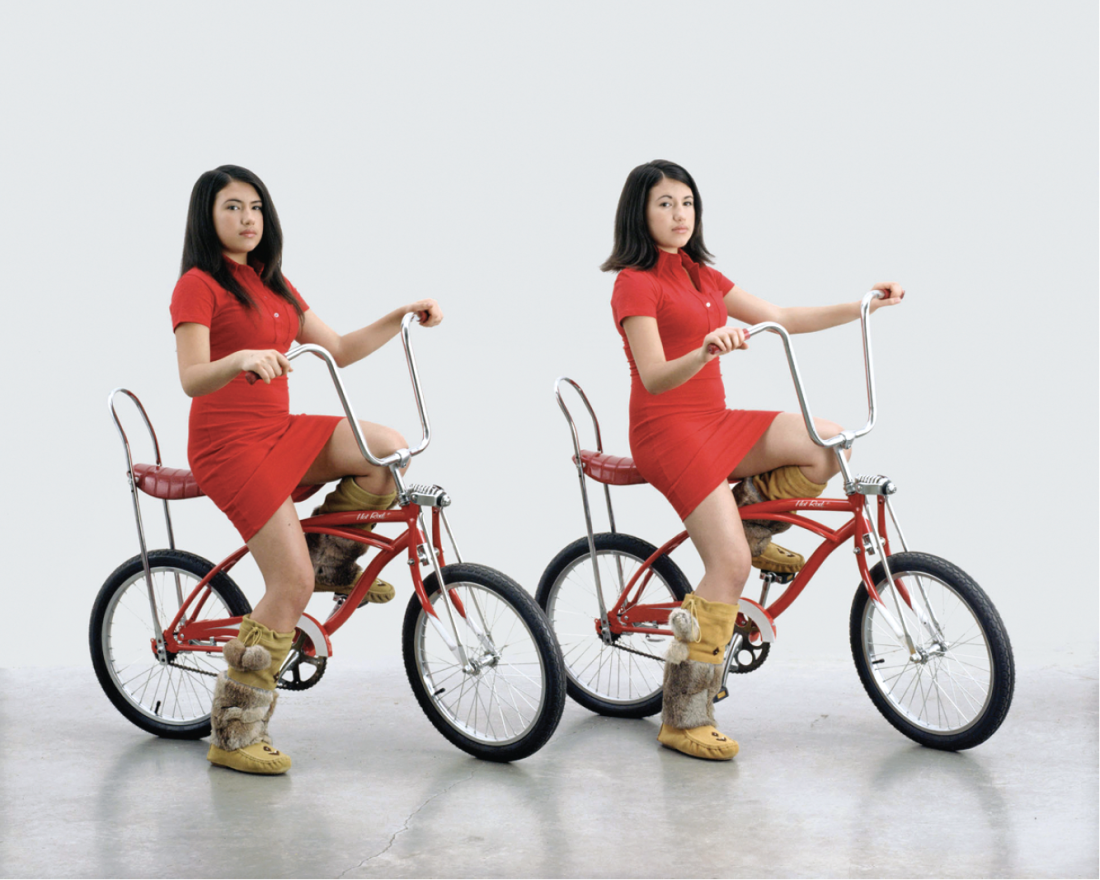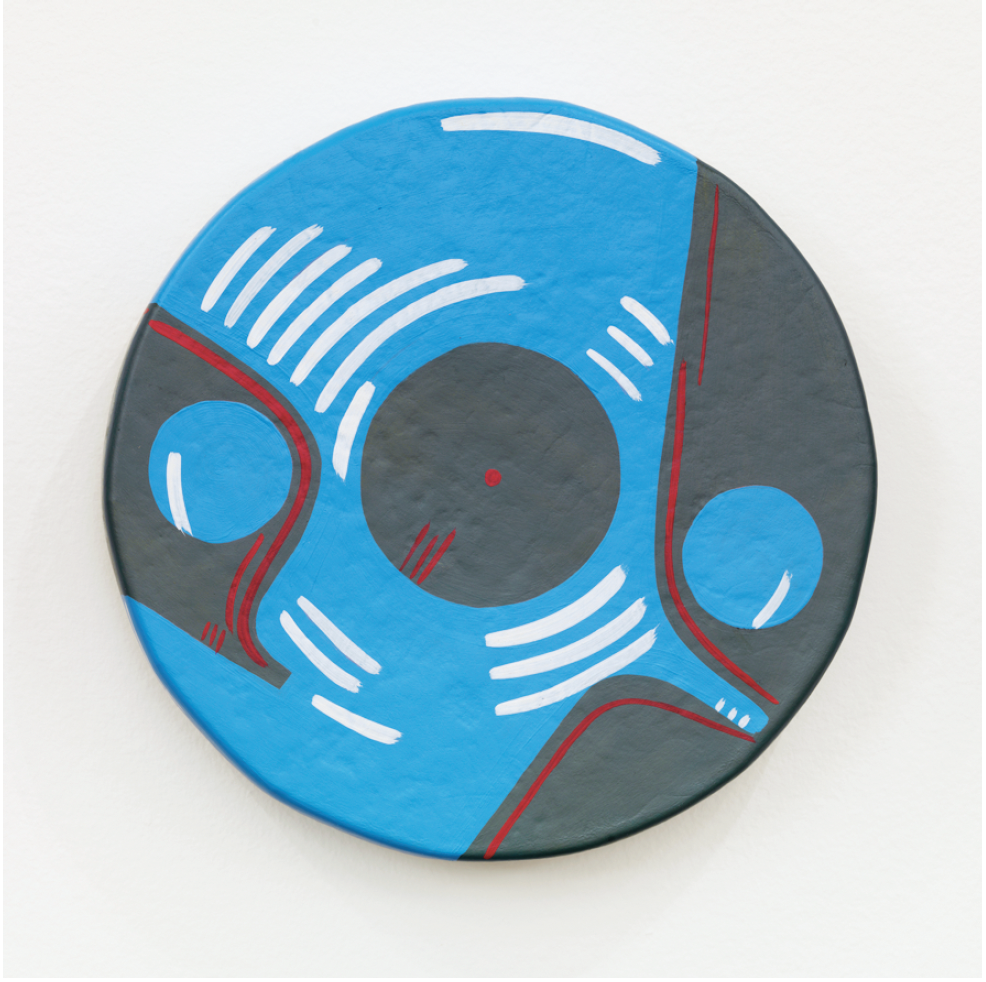“Beat Nation”
As you walk up the circular, marble-clad stairway in the neo-classical rotunda of the Vancouver Art Gallery, you hear the throbbing bass of electronic music. The image that confronts you, however, when you enter the second floor gallery, is not at all what you would expect. Yes, a videotaped dancer is projected on a large screen in the middle of the room, but he does not wear the garb nor move the way you would expect him to given the audio cues. Instead, you see a young man clad in traditional Tlingit ceremonial regalia—wooden mask, Chilkat robe, fringed apron and leggings—performing a stately Raven dance in front of a large, vividly painted, Northwest Coast dance screen.
And this is not the only contradictory cultural crossover, not the only hip-hop flip-flop that Tlingit artist Nicholas Galanin has up his trickster-like sleeve. The second part of his video shows a young man dressed in a sweatshirt and jeans, “popping” and “waving” to the sounds of traditional Tlingit drumming and singing. Like a young Michael Jackson rehearsing in an empty studio, he slides and glides forward, backward and sideways, his body given over to sometimes robotic, sometimes fluid movement. Galanin is asking us to consider a contemporary aboriginal reality, planted at the fertile interface between today’s Westernized urban youth culture and age-old tribal forms and beliefs. The global village, it seems, has met the Native ’hood.

Dana Claxton, Baby Girlz Gotta Mustang, 2008, lightjet C-print, edition of 4, 4 x 5’. Courtesy the artist and Winsor Gallery, Vancouver.
Galanin’s video, Tsu Heidei Shugaxtutaan (We Will Again Open This Container of Wisdom That Has Been Left in Our Care), parts 1 and 2, 2006, is a beguiling introduction to a stimulating group exhibition of contemporary First Nations art. “Beat Nation: Art, Hip Hop and Aboriginal Culture” surveys the work of 27 artists from across Canada and the United States. Among the diverse communities represented are Kwakw_a_k_a_’wakw, Tsimshian, Apache, Cree, Anishinabe, Mi’kmaq and Navaho, and the artists here fuse, as Galanin does, traditional aboriginal forms of expression with those newly gleaned from the street. Emerging artists show alongside the internationally acclaimed, the most notable of these being Brian Jungen, who is represented by a selection of his genre-busting “Northwest Coast” masks, uncannily fashioned, in the early 2000s, out of Nike Air Jordans and collectively titled “Prototypes for a New Understanding.” Jungen has a brilliant capacity to transform everyday objects—from shipping pallets to plastic lawn chairs—into socially, politically and historically charged sculptures and installations. Sports equipment, however, has its own particular, appropriative resonance. (Think of all the professional sports teams that have “Indian” names.)
While the rap and hip hop metaphors of the exhibition dictate a large representation of performance-based works, including audio and video installations, costumes and masks and a dozen music videos selected and DJed by Ostwelve, aka Ron Dean Harris, other pop-culture and street-inspired forms and media are also plentiful. These include Michael Nicoll Yahgulanaas’s car hoods, painted in his distinctive “Haida manga” style; Duane Linklater’s neon Thunderbird, based on a Norval Morrisseau image; KC Adams’s beaded MacBook Pro electrical cord, standing erect like a rattlesnake about to strike; and Dana Claxton’s punning C-print of young Lakota twins, wearing fringed buckskin boots and sitting on “Mustang” low-rider bicycles. Visual smarts and political sauciness sizzle throughout.
Originally curated by Secwepemc artist Tania Willard, “Beat Nation” started out in 2008 as a project of Vancouver’s grunt gallery, a small, artist-run centre that has long supported First Nations exhibitions and performances. In this expanded, mainstream incarnation, Willard has worked with non-Native VAG curator Kathleen Ritter, to apparently happy effect. At the show’s media preview, Ritter remarked that Aboriginal hip hop is “an important forum for storytelling, indigenous languages and political activism,” and its forms and strategies have been cleverly consolidated by visual artists.

Michael Nicoll Yahgulanaas, Coppers from the Hood “Terse Cell,” 2010, copper leaf and ink on car hood. Courtesy the artist and Gordon Diamond.
Although the journey is not laid out here, it is fascinating that hip hop culture, with its cornerstones of MCing/rapping, DJing/scratching, breaking/dancing, and graffiti writing, has spread around the world from its African-American roots in the Bronx in the 1970s. As typified by its adaptation by First Nations artists, it has been globally appropriated by marginalized, politicized and often angry youth. And while its original advocates might complain that hip hop has become too mainstream to be believable as an alternative cultural form, it still thrives as an expression of streetwise and anti-authoritarian identity for urban youth anywhere, anyhow. As this exhibition demonstrates, hip hop remains a primary means of assertion of otherwise disenfranchised voices.
Sonny Assu, whose Kwakw_a_k_a_’wakw heritage richly informs his reinterpretation of popular-culture forms and motifs, is represented here by two large, wall-mounted installations. One of them, Billy and the Chiefs: The Complete Banned Collection, 2012, consists of nine sets of elk-hide drums, painted in a way that fuses the appearance of vinyl records with abstracted elements of Northwest Coast graphic design. The inspiration for this work, which has 67 components, was a collection of ethnographic LPs, made in 1967. These include recordings of Assu’s great-grandfather, Chief Billy Assu of Cape Mudge, and the acclaimed Kwakwakw_a_k_a_’wakw artist Mungo Martin, singing ceremonial songs in their native tongue. As with other, earlier works, Sonny Assu manages to combine appealing and even humorous pop culture forms with serious political and historical messages: the number of painted drums in this installation represents the number of years the potlatch was banned in Canada. It is now well known how integral the potlatch was to the indigenous cultures of the Northwest Coast; Assu’s non-playing records effectively symbolize the length of time First Nations peoples were silenced.
Maria Hupfield, an Anishinabe artist based in Brooklyn, NY, has produced some of the most understated yet powerful works in the show. Working across disciplines, from performance to sculpture, she draws a number of contemporary issues and ideas into the forum of her art. These, the exhibition curators tell us, include the ways in which our relationships with both the natural and built environments are determined by imposed systems of measurement, and the use of the body as “a site of resistance and agency.” The continuously looping video in Hupfield’s Survival and Other Acts of Defiance shows her jumping up and down unendingly while wearing a pair of “jingle boots.” Their shup, shup, shup sound reverberates through the gallery, declaring a kind of freedom zone, and yet the artist’s action is forever delimited by a large X marked in silver duct tape on the floor in front of the video projection. (Wonderfully, the intersection of the two bars of the X, each composed of three parallel strands of duct tape, is woven together, creating a subtle image of handmade-ness.)

Sonny Assu, detail of Billy and the Chiefs: The Complete Banned Collection, 2012, 67 painted hide drums, dimensions variable. Photograph: Rachel Topham. Courtesy the artist and the Vancouver Art Gallery.
Hupfield’s sewn textile sculptures include Bear Mask with Ear to the Ground, 2011, a spooky teddy bear head with empty eyes and no mouth, and Memory Sticks, 2011, a series of sewn fabric “bones” laid out in a vitrine. The body is evoked here again as it locates itself on the nature-culture interface. The fabric used for both works is a synthetic silver lamé, its mineral colour and shine having particular symbolic resonance, including suggestions of historical currency, such as trade silver. The trade silver metaphor is reiterated in Hupfield’s heavily adorned, felt jingle boots, with their rows and rows of percussive metal horns.
Kent Monkman’s single channel video, Dance to Miss Chief, 2010, is hilariously camp. At the same time, it investigates serious themes of racial and sexual stereotyping. Bedecked and bedazzling as his performance alter ego, the transvestite “Miss Chief Eagle Testicles,” Monkman poses himself against scenes appropriated from a dubious series of German “Westerns,” made in the 1960s from the earlier, equally dubious but phenomenally successful “Winnetou” novels by German writer Karl May. In the films, shot in what was then Yugoslavia, blue-eyed, German-speaking, Caucasian actors wearing brown makeup and black wigs pretend to be dancing, drumming, flaming-arrow-shooting North American “Indians.” They seem to be fulfilling some kind of weird, racialized, German cultural fixation, which Monkman humorously critiques.
Sadly, no catalogue has been produced for “Beat Nation,” nor are there plans to tour the show to other galleries. Happily, it has had a long and stimulating run in Vancouver—and we are the richer for it. ❚
“Beat Nation: Art, Hip Hop and Aboriginal Culture” exhibited at the Vancouver Art Gallery from February 25 to June 3, 2012.
Robin Laurence is a Vancouver-based writer, curator and Contributing Editor to Border Crossings.

